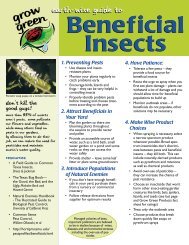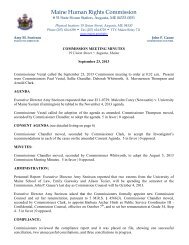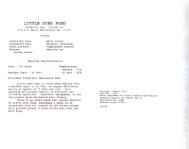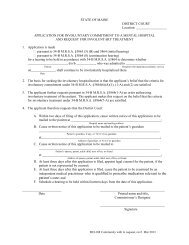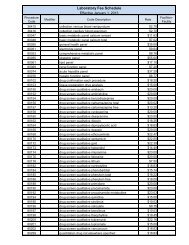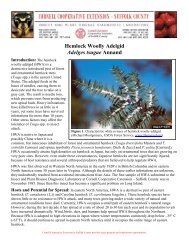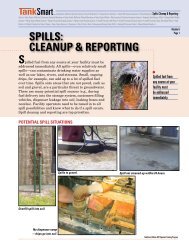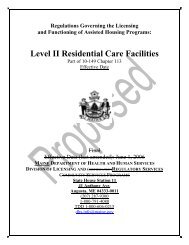TICK-BORNE DISEASES IN MAINE - Maine.gov
TICK-BORNE DISEASES IN MAINE - Maine.gov
TICK-BORNE DISEASES IN MAINE - Maine.gov
You also want an ePaper? Increase the reach of your titles
YUMPU automatically turns print PDFs into web optimized ePapers that Google loves.
BABESIOSIS<br />
AGENT<br />
Parasite: Babesia microti<br />
Tick: Ixodes scapularis<br />
Signs/Symptoms<br />
[incubation period: 1-6 weeks]<br />
• Malaise, fatigue<br />
• Sustained or intermittent fever, chills<br />
• Gastrointestinal symptoms (anorexia,<br />
nausea, abdominal pain, vomiting)<br />
• Myalgia<br />
• Arthralgia<br />
• Depression, emotional lability<br />
• Photophobia<br />
• Conjunctival injection<br />
• Dark urine<br />
• Petechiae, splinter hemorrhages,<br />
ecchymoses<br />
• Mild splenomegaly and/or<br />
hepatomegaly<br />
• Cough<br />
• Sore throat<br />
Labs<br />
Common Findings on Routine<br />
Laboratory Tests<br />
• Decreased hematocrit secondary to<br />
hemolytic anemia<br />
• Elevated reticulocyte counts<br />
• Elevated erythrocyte sedimentation<br />
rate<br />
• Thrombocytopenia<br />
• WBC count may be normal or mildly<br />
decreased<br />
• Decreased serum haptoglobin<br />
• Elevated serum BUN and creatinine<br />
• Mildly elevated hepatic transaminases<br />
• Proteinuria<br />
• Hemoglobinuria<br />
• Direct Coombs’ test may react<br />
positively<br />
Diagnostic Laboratory Criteria<br />
• Positive PCR assay (preferred method);<br />
or<br />
• Identification of intraerythrocytic<br />
Babesia parasites in a peripheral blood<br />
smear or<br />
• Isolation of the parasite from a whole<br />
blood specimen by animal inoculation.<br />
NOTE: Due to the sparse parasitemia<br />
typical of most Babesia microti infections,<br />
additional diagnostic tests should be<br />
performed in suspect patients if the initial<br />
blood smear is negative.<br />
Supportive Laboratory Criteria<br />
• Demonstration of a Babesia-specific<br />
antibody titer by Immunoflourescent<br />
Antibody (IFA) test for IgG. In general,<br />
higher cutoff titers (> 1:256) are<br />
associated with greater diagnostic<br />
specificity.



